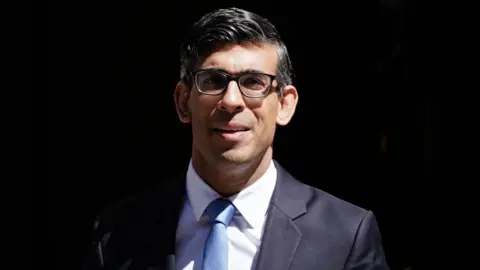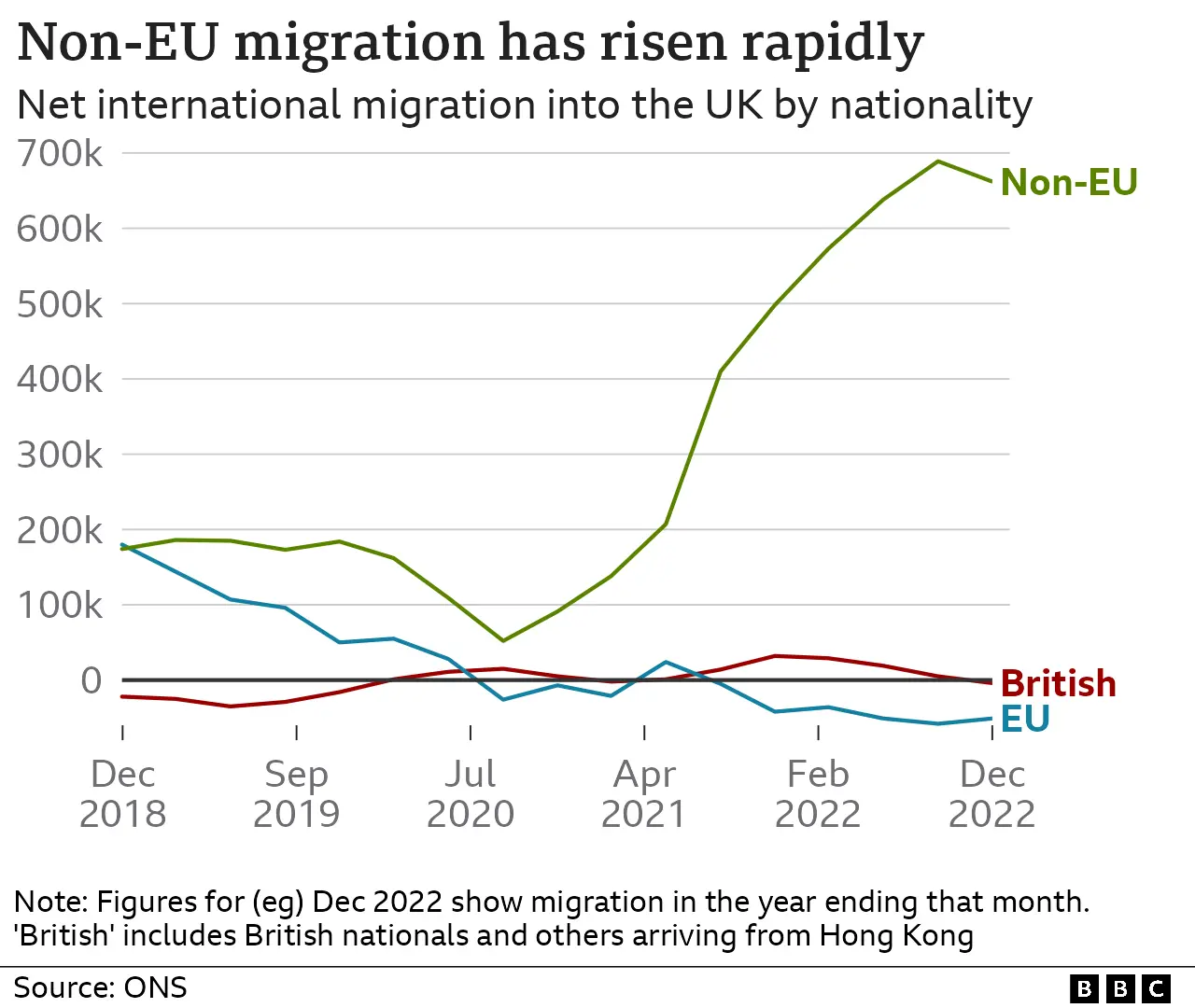Migration figures: Rishi Sunak denies he's lost control of rising migration
 PA Media
PA MediaNet migration is too high, Rishi Sunak has said, after data confirmed levels hit a new record high last year.
Immigration saw the country's overall population increase by 606,000 in 2022, according to the Office for National Statistics (ONS).
More people from outside the EU arriving on student and work visas, as well as the Ukraine and Hong Kong schemes, all contributed, the ONS said.
The PM insisted that migration was not out of control.
But after more than a decade of Conservative-led governments promising to reduce numbers, the figures represent a political challenge for Mr Sunak.
Under then Conservative prime minister David Cameron, the Tories pledged to get net migration below 100,000, and the party's 2019 manifesto also committed to getting the rate down, without setting a specific target.
Now the ONS has confirmed that in 2022, an estimated 1.2 million people arrived in the UK, while 557,000 left in the same period.
Net migration, the difference between those two figures, stood at 606,000 - an increase of 164,000 on 2021's total.
Reacting to the data, the PM told ITV's This Morning: "Numbers are too high, it's as simple as that. And I want to bring them down."
Asked whether immigration was out of control, Mr Sunak replied: "Well, no, I think the numbers are just too high."
The PM said measures to tighten visa rules for overseas students which were put in place this week were "significant" and would bring levels down over time.
In a bid to drive down net migration, from next year, only those on post-graduate research programmes will be able to bring their families to the UK.
On Thursday, the ONS said that of the 925,000 non-EU nationals who came to the UK in 2022, almost 40% arrived on student visas - but it added that students "typically" don't stay long term, and the majority leave when their courses end.
The Russell Group, which represents many of the country's top universities, has raised concerns that the plans will impact their ability to attract the "vital income" international students inject into the British higher education system.

The second biggest driver of the 2022 increase was the number of work-related arrivals from outside the EU, which nearly doubled from 137,000 to 235,000 in the space of a year.
Net migration continues to increase despite Brexit: more EU nationals left the UK last year (202,000) than arrived (151,000), the ONS said.
Resettlement schemes triggered by what the ONS called "unprecedented world events" were the third biggest driver of the increase.
The number of non-EU nationals who arrived in the UK via humanitarian routes rose from 9% to 19% in 2022.
Among them were 114,000 Ukrainians, and 52,000 Hong Kong citizens who were offered a special visa scheme created after China imposed a national security law in the former British colony.
In the House of Commons, Labour's shadow home secretary Yvette Cooper said support given to Ukrainians and Hong Kongers had "unusually affected the figures".
"Net migration is more than twice the level ministers were aiming for, and the asylum backlog is at a record high despite Rishi Sunak promising to clear it this year," she said.
Ms Cooper criticised the government for failing to tackle skills shortages, especially in health and social care, or to get people back into work after the pandemic.
Immigration minister Robert Jenrick said: "We want British employers to focus… on training British workers to fill these vacancies."
He added that he worried high net migration was placing "intolerable pressure on public services, on housing supply and on our ability as a country to integrate new arrivals".
"What we do want to see is universities focusing on teaching and not on inadvertently creating a backdoor to immigration status here," he added.


Could the government's 2010 net migration target of tens of thousands ever be hit?
As Oxford University's Migration Observatory points out, non-EU migration has significantly risen thanks to the UK welcoming people from Ukraine and Hong Kong, a post-pandemic increase in international students and a jump in visas for skilled workers - particularly in health and care.
We're expecting Ukraine and Hong Kong arrivals to dry up - and worker entries may stabilise. The departure of international students should increase while many new ones will no longer be able to bring relatives.
Figures could drop by another 70,000 if the government's controversial plan to divert abroad almost all asylum claims works - but that's an "if" the height of the white cliffs of Dover.
If Rishi Sunak delayed the general election until January 2025 - the last possible date - he should be able to show net migration has fallen significantly.
But it is impossible to say from here that tens of thousands could ever be achievable.

The ONS pointed out that the latest figures reflect changes made during the pandemic in how official migration figures are calculated.
Projections are now linked more to government data rather than surveys of passengers arriving at British ports, and asylum seeker numbers are now included.
BBC Verify estimates asylum seekers make up about 8% of immigration into the UK from outside the EU.
Last year, 76,000 people applied for asylum in the UK, 23,000 more than the previous year.
The number doesn't include everybody who arrived in small boats, but the Home Office estimates about 90% of people who arrive that way go on to seek asylum.
On the backlog of asylum claims, Downing Street said the government was focused on reducing the number of people waiting and measures such as doubling the number of case workers would "take time to bed in".
Dr Peter Walsh, of Oxford University's Migration Observatory, described the current period as "very unusual" and said the UK was a popular destination for foreign students and workers.
He told BBC Breakfast there have been initiatives from the government and universities to recruit more students, particularly from countries like India and Nigeria.
"They also last year brought around 100,000 partners and children," Dr Walsh added.
"International students pay the high fees which subsidise the education of domestic students."

